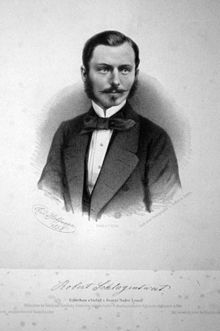

Robert von Schlagintweit (24 October 1833 – 6 June 1885) was a German explorer of Central Asia who also wrote about travels in America. Brothers Hermann, Adolf and Robert Schlagintweit were commissioned by the British East India Company to study the Earth's magnetic field in South and Central Asia. They were the first Europeans to cross the Kunlun Mountains and the first to explore the region between Karakoram and Kunlun.
Life
The fourth of the five Schlagintweit brothers of Munich joined his brothers Hermann and Adolf at an early age in their Alpine researches and jointly published Neue Untersuchungen über die physikalische Geographie und Geologie der Alpen in 1854.
In 1854, acting on the recommendation of Alexander von Humboldt, the East India Company commissioned Hermann, Adolf, and Robert to make scientific investigations in their territory and particularly to study the Earth's magnetic field. For the next three years they travelled through the Deccan, then up into the Himalayas, Karakoram, and Kunlun Mountains. Hermann and Robert were the first Europeans to cross the Kunlun.
Subsequently, Robert returned to Europe, and became a professor of geography at the University of Giessen in 1863. He made several trips to America between 1867 and 1870. Starting in Boston with the Lowell Institute with a series of twelve lectures on "Orography and Physical Geography of High Asia," he gave lectures throughout the United States. He also explored the Pacific coast. He wrote several books on American subjects, including Die Pacificeisenbahnen in Nordamerika (1870), Kalifornien (1871), Die Mormonen (1874), and Die Prärien des amerikanischen Westens (1876).
Botanical collections
Botanical specimens collected by the Schlagintweit brothers are held at several herbaria around the world, including the Philadelphia Herbarium at the Academy of Natural Sciences (PH) and National Herbarium of Victoria at the Royal Botanic Gardens Victoria. Numerous specimens were collected by their team; twenty-four specimens have been credited partially or fully to him.
In 1853, botanist Griseb. published Schlagintweitia, a genus of flowering plants from Europe, belonging to the family Asteraceae, with its name honouring Robert Schlagintweit and his brothers Herman and Adolf.
Notes
- ^ Chisholm 1911, p. 328.
- Wilson & Fiske 1900.
- Harriet Knight Smith, The history of the Lowell Institute, Boston: Lamson, Wolffe and Co., 1898.
- "The Australasian Virtual Herbarium". The Australasian Virtual Herbarium. Council of Heads of Australasian Herbaria (CHAH). 2021. Retrieved 26 October 2021.
- Binomia: Robert Schlagintweit. Accessed 24 June 2023.
- "Schlagintweitia Griseb. | Plants of the World Online | Kew Science". Plants of the World Online. Retrieved 25 May 2021.
References
- Attribution
 This article incorporates text from a publication now in the public domain: Chisholm, Hugh, ed. (1911). "Schlagintweit". Encyclopædia Britannica. Vol. 24 (11th ed.). Cambridge University Press. p. 328.
This article incorporates text from a publication now in the public domain: Chisholm, Hugh, ed. (1911). "Schlagintweit". Encyclopædia Britannica. Vol. 24 (11th ed.). Cambridge University Press. p. 328.- Andreas Daum, Wissenschaftspopularisierung im 19. Jahrhundert: Bürgerliche Kultur, naturwissenschaftliche Bildung und die deutsche Öffentlichkeit, 1848–1914. Munich: Oldenbourg, 1998, pp. 113, 388, 414, 509, including a short biography.
- Wilson, J. G.; Fiske, J., eds. (1900). "Schlagintweit, Robert von" . Appletons' Cyclopædia of American Biography. New York: D. Appleton.
External links
- Die Geschichte der Brüder Schlagintweit A detailed story of the adventures of the three brothers Hermann, Adolf and Robert in India and the Himalayas. (in German) (archived)
- Schlagintweit.de
- Hermann, Adolph, Robert und Emil Schlagintweit Nachlass (1854 – 1857. Weiteres Material zur Asienreise, Photographien und Zeichnungen von Menschen. BSB Schlagintweitiana IV.2.